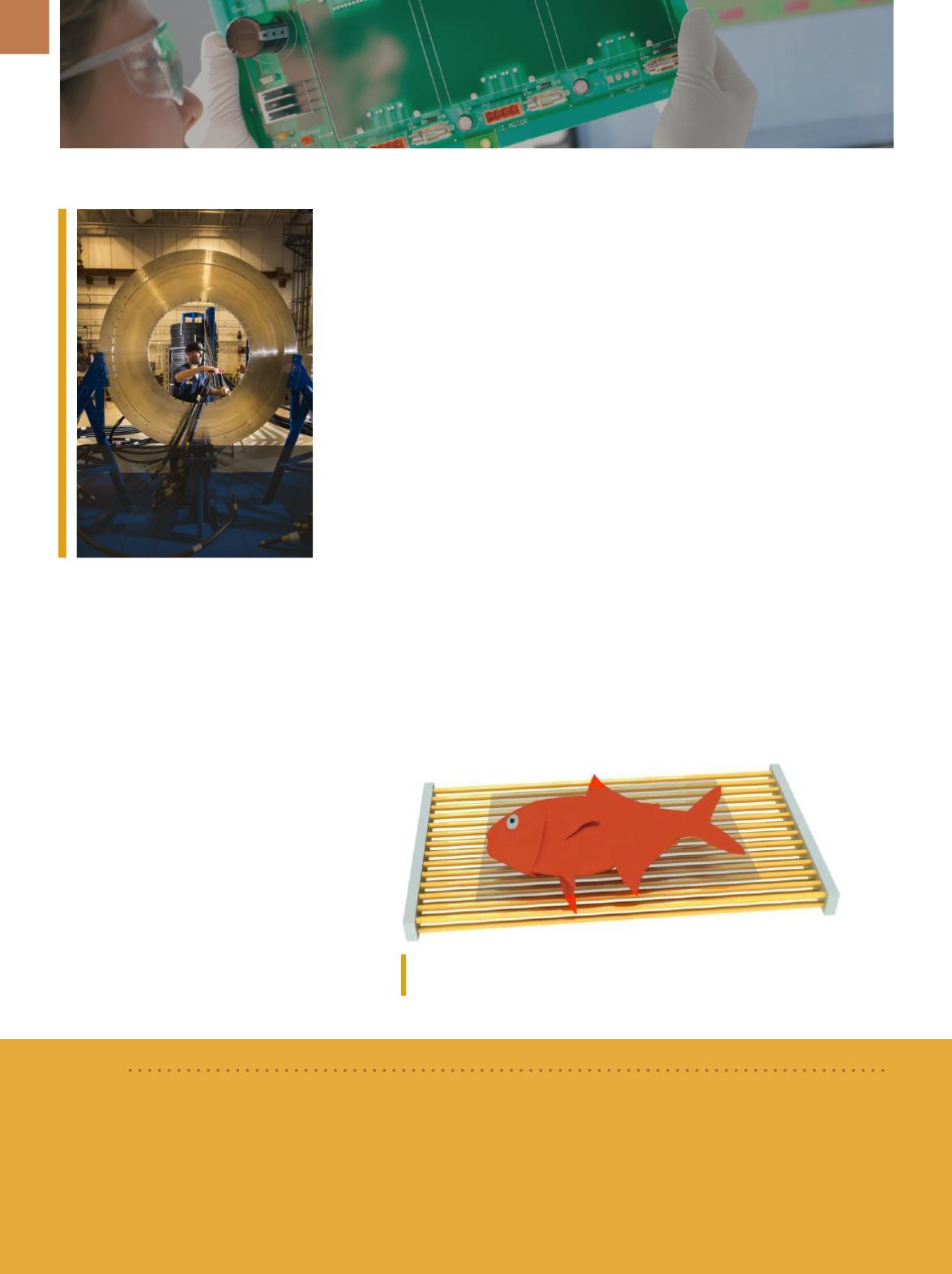

THOR ACCELERATOR SMASHES
Z MACHINE IN EFFICIENCY
A new accelerator developed
by Sandia National Laboratories, Al-
buquerque, N.M., is expected to be
40 times more efficient than their Z
machine, the world’s largest and most
powerful pulsed-power accelerator.
Named Thor, the new device will be
used to study materials under extreme
conditions. “Thor’s magnetic field will
reach roughly one million atm, about
the pressures at Earth’s core,” says Da-
vid Reisman, lead theoretical physicist
on the project. Though unable to match
Z’s 5 million atm, Thor will be small-
er—2000 ft² rather than 10,000 ft²—and
considerably more efficient because it
uses hundreds of small capacitors in-
stead of Z’s few large ones.
While Z’s elephant-sized capaci-
tors require large switches to shorten
the machine’s electrical pulse from
1 µs to 100 ns, Thor’s small switches
immediately discharge current in a
100-ns pulse, eliminating energy loss
from compression. The new archi-
tecture also allows for tailored pulse
shapes, avoiding the shocks that force
materials to change state. While it can
take days for Z machine users to de-
termine how to create the ideal pulse
shape for a desired compression curve,
Thor users will be able to do the same
after just moments at a computer. San-
dia is building Thor in stages and has
already assembled materials for two
intermediate “first light” machines ex-
pected in 2016.
sandia.gov.METAMATERIALS
ENHANCE MRI
A group of researchers from Rus-
sia, Australia, and the Netherlands
developed a technology that can dra-
matically increase magnetic resonance
imaging (MRI) efficiency, resolution,
Technician Eric Breden installs a
transmission cable on the silver disk
that is the new pulsed-power ma-
chine’s central powerflow assembly.
Courtesy of Randy Montoya.
Placing a unique metamaterial under an object in an MRI scanner boosts the
signal-to-noise ratio in the scanned area.
BRIEF
A research team from the faculty of engineering at the
National University of Singapore
has achieved a world’s first
by successfully converting paper waste into green cellulose aerogels that are nontoxic, ultralight, flexible, extremely
strong, and water repellent. This novel material is well suited for applications such as oil spill cleaning, heat insula-
tion, and packaging. Additionally, it can potentially be used as a coating in drug delivery and as smart material for
various biomedical applications.
www.nus.edu.sg.
and safety by using metamaterials—
artificial periodic structures that in-
teract with electromagnetic radiation.
The scientists—from ITMO University,
Ioffe Physical-Technical Institute, and
the Institute of Experimental Medicine
RAMS (all in Russia), Australian Nation-
al University, and University Medical
Center Utrecht, the Netherlands—de-
termined that placing a specially de-
signed metamaterial under the studied
object in an MRI scanner increases the
signal-to-noise ratio in the scanned
area. As a result, either a higher reso-
lution image can be obtained over the
same scanning time, or an image of
normal resolution can be produced in
less than half the time. Additionally,
the metamaterial suppresses the elec-
tric field, which is responsible for tissue
heating, a phenomenon that may com-
promise patient safety. Implementation
of the metamaterial solution does not
require any intervention into the MRI
hardware, but simply involves an inex-
pensive add-on device that can be used
with any scanner.
en.ifmo.ru/en.EMERGING TECHNOLOGY
A D V A N C E D M A T E R I A L S & P R O C E S S E S | A P R I L 2 0 1 6
1 2


















